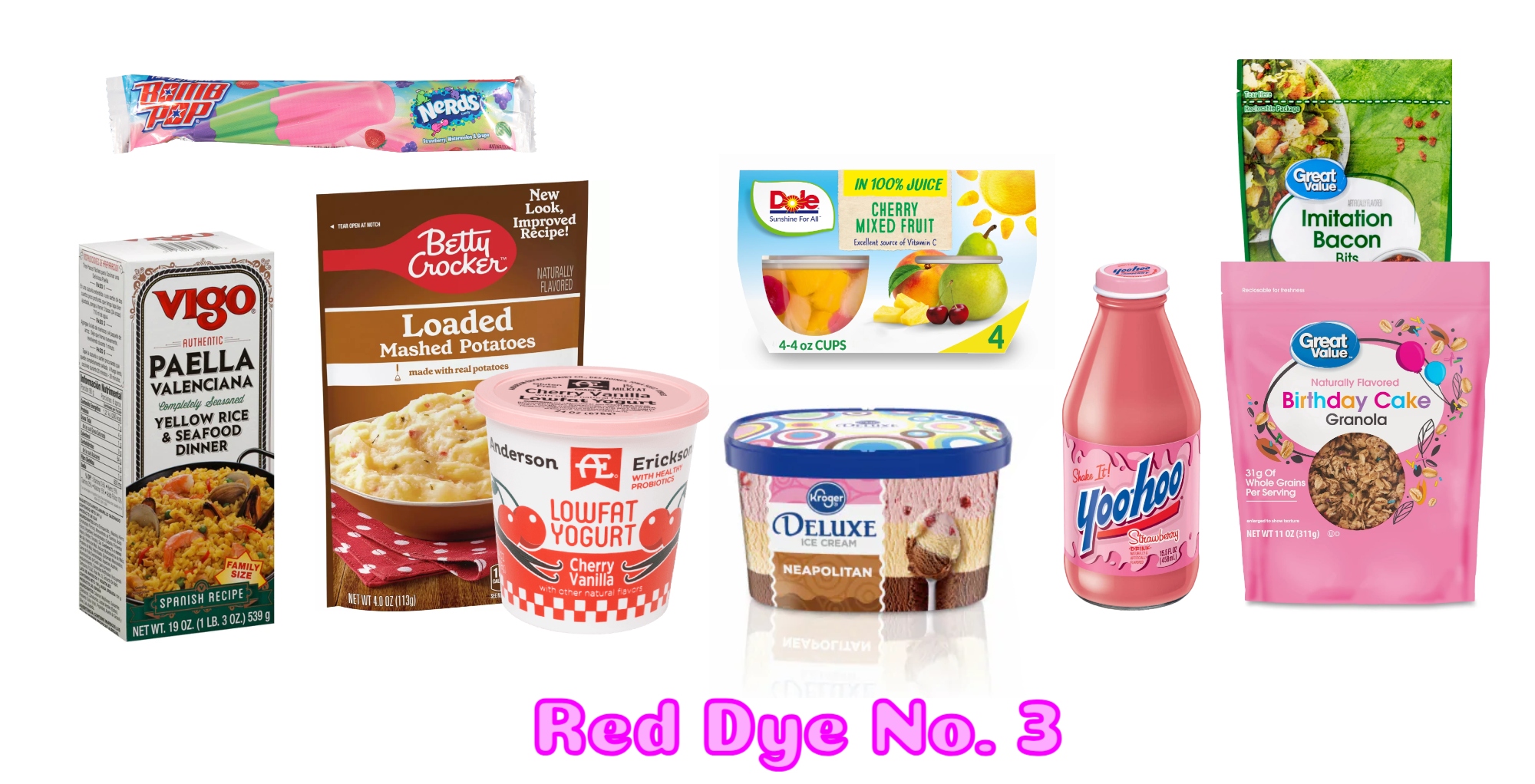
Red dye No. 3 is a synthetic food coloring used in gummies, fruit cups, frostings, toaster pastries, candies such as Skittles and Peeps, and more. In fact, it’s reportedly used in nearly 3,000 different products. Parents and health professionals have long accused it of triggering behavioral issues, something that a study has confirmed.
The California Legislature just passed the California Food Safety Act, which bans the sale of food and drinks containing red dye No. 3 along with potassium bromate, brominated vegetable oil and propylparaben, three other harmful chemicals that are frequently found in processed foods. In light of the bill passing, parents and doctors are sharing stories about the effects red dye No. 3 can have on kids.
It can trigger irritability: Father of three Matt Parks tells Yahoo Life that he and his wife try to do their best to keep their children from having red dye No. 3. “We have noticed that when our youngest daughter has red food dye, her ability to regulate emotions becomes impaired,” he says. “She’s very easily agitated and upset — far more than normal. It’s gotten to the point where even she notices the change.” Parks says he has ADHD and notices that, when he has products with red dye No. 3, he feels more irritable and agitated. “It’s not a cause of those symptoms, but it does seem to be a trigger,” he says.
It can cause hyperactivity: Father of two AJ Yarwood also says his family tries to avoid red dye No. 3. “When our children consume products containing red dye No. 3, they tend to become more hyperactive and have difficulty focusing,” he tells Yahoo Life. “This can be especially challenging for our daughter, who already struggles with attention issues.”
It’s already banned from cosmetics: Yarwood says his family has come up with a list of common products with the dye to avoid, noting that the list keeps growing. “It’s frustrating to know that this dye is banned from cosmetics due to its harmful effects, yet it’s still used in everyday foods for everyone to ingest,” he says.
The claims aren’t just anecdotal: The chemical has been linked to behavioral issues in kids. Jamie Alan, an associate professor of pharmacology and toxicology at Michigan State University, says that studies on red dye No. 3 are limited and only show an association — not that red dye No. 3 actually causes certain health issues or behaviors. But Alan says it’s important to consider this: “Red dye offers no nutritional or positive impacts on health. There is only potential harm, although the jury is out on the amount of type of harm it may or may not cause. From a health standpoint, I can see benefits” to banning the dye in foods.
Docs love the idea of banning red food dye: Dr. Daniel Ganjian, a pediatrician at Providence Saint John’s Health Center in Santa Monica, Calif., tells Yahoo Life that he “loves” the idea of banning red food dye. Ganjian says he’s seen kids act out after having candies with red dye No. 3. “It’s not just the sugar,” he says. “It’s just better not to have this ingredient.”
What can parents do now? If you’re able to, Alan recommends doing your best to avoid red dye No. 3, either by choosing dye-free foods or ones that use more natural coloring, such as beet extract. “I am concerned about parents who cannot easily access foods that are dye-free,” she says. “If your only options for food are foods that contain dye, then by all means feed your children.”
If Governor Newsome signs the bill into law, any foods containing these chemicals can no longer be sold in California, effective in 2027. That’s plenty of time for companies to loudly throw their tantrums and then come up with safer, alternate solutions, right? This isn’t the first time California has led the nation in making a big move. Back in 2021, it was the first state to require school children to get the covid vaccine. As for that last part about whether or not parents can easily access foods that are dye-free, I know I’m preaching to the choir here, but it would be great if we could just make healthier foods more affordable and accessible to everyone, so no one has to be backed into a financial corner when it comes to their health. I also think it’s interesting that red dye No. 3 was banned in cosmetics but we’re still able to put it into our bodies.
And just a side ponder, but I do wonder how the conservative mommy blogger crowd is reacting. On one hand, they hate the government for trying to help keep their kids safe through things like vaccinations and face masks. On the other hand, I’m sure they’ve been sharing all sorts of info-graphics about red dye being poison while calling for that no-good government to do something about it. What do they do now? First one to see a former high school classmate post outrage memes about banning red dye No. 3 to their social media has to report back, okay?
Photos credit: Lam Loi on pexels and via Kroger/Walmart/Environmental Working Group












Banning red dye…But no ban on guns. Ha! America is absolutely NUTS!!!
California has an almost total ban on assault rifles, manufacture, sale, and possession. Obviously we have considerable gun violence in CA but some effort at sensible gun laws, fwiw.
It’s worth noting that you’re less likely to die of gun violence in CA than anywhere else in the country.
California has the strictest gun laws in the country. As for total bans, the 2nd Amendment exists and until the Constitution is updated, no amount of of restrictions in one state will prevent people from getting the guns from another.
The US is more akin to the EU in structure than a single unified country.
California has been pushing for gun bans and control for a very long time. A lot of efforts are thwarted at federal court when republicans bring laws, that Californians want and voted for, into question and get them overturned.
San Francisco, my home, kicked out its last gun shop back in 2013-2014 (can’t recall exact date).
Let’s not go all whatabouting when the issue of dyes in food is real and very problematic and they should be banned on a broader level.
Finally! I have always had problems with this dye. My parents recognized it very early on. This was in the 80s. It would make me hyperactive and then irritable and then throw up. I have avoided it into adulthood. But… one day I decided to have some red Kool Aid. Apparently the adult version of these symptoms is extreme anxiety and irritable bowels. Not pleasant.
You have a completely valid point. But nobody is saying the dye causes ADHD. It is an acute reaction to the dye.
I have had to become s food label reader after my daughter had an anaphylactic reaction to red dye in food. After a scary ambulance ride and a long string of allergy tests, which were all normal, the only culprit left standing was food dye. There is no allergy test for artificial dye, it’s a process of elimination. Even prepared pie crust contains dye among other products that you would never expect, such as pill coating! Germany, as well as other countries, have long abandoned artificial coloring. Glad to see we some progress here.
These giant companies don’t include these ingredients in their European products, there is no reason aside from cost that they can’t do it here. Aside from cost. But they will do anything to cut costs at the expense of our health. I hope this leads to changes outside of California too. But it depends on how much the companies line the pockets is the politicians making these decisions. Just as it is with guns and any other powerful lobby.
Yes!! I have found a grocery chain that carries European brands and they use food based natural coloring , beet, turmeric, etc.
@Libra, what is the store that carries European products? I’ve always commended how they are way ahead of the US as far as allowing ingredients in their foods. This is a great first step. Our family went to England last year and compared ingredients to the US commonly found products to their European counterparts, and the difference was shocking.
@Christine, is there a World Market near you? It’s not a substitute for a grocery store, but they have a lot of European products. So does Rodman’s in the DC area.
Also, Trader Joe’s doesn’t use artificial flavors, colors, or preservatives.
@christine, I go to our local Aldi.
I’m in Ireland and most of these have been banned or restricted here (EU) since 1994… My sister has often brought home sweets etc. from the States and the ingredient list on some of them is like a chemistry experiment!
Finally! And food coloring must be banned from pet food too.
Why is it that large companies must be monitored all the time or they do shitty things? Why are they so greedy and disgusting?
I’m also allergic to red dye. Everyone treated me like a weirdo and a liar. Then i read an article about it 15 years too late.
It became really apparent when I drunk this EXTREMELY cheap red punch. You could taste the chemicals. Hopefully this dye ban goes cross-country. I also need blue dye and possible purple banned.
I got so much grief from my family when I wouldn’t let my kids eat anything with artificial coloring. So.much.grief.
The stomach acid involved in the digestive process neutralizes a lot of things that the pH of your skin wouldn’t, hence why you can get away with certain things in food that you can’t in skin products. The question then becomes, “what does the product break down into after digestion?” That’s what your study needs to show to verify risk.
Red 3 was banned from cosmetics because of the carcinogenic effects it showed in animals. It may not have the same effects if the carcinogenic molecules are destroyed by stomach acid, but I wouldn’t be surprised if some people have sensitivity responses to it, especially if any of the byproducts are lipid soluble. That would allow them to accumulate in tissues and cross the blood-brain barrier more easily. When you’re dealing with a population the size of the United States, you’re bound to unearth these problems more often simply because you have such a large sample size. Certainly no reason it can’t be removed from use if we’re seeing trending issues. Allergies are inevitable in some segments of the population, but safety should be scaled to risk.
Yes.
Cue the Republican led government and legislature in Montana enacting a second “ban on bans” to included a “ban on banning red dye”. They literally passed a law banning bans on plastic containers. I predict you will see Kid Rock drinking a vat of red dye along with Ted Cruz by Monday morning
@skyblue, you just made me snort water out of my nose while laughing. Cheers!
Now BAN RED 40!!!
Wild. I’ve heard so much anecdotal evidence about this, for decades now.
Yay, CA!
—now, ban them all!